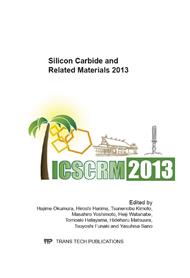[1]
P. G. Neudeck, Progress towards high temperature, high power SiC devices, in Institute of Physics Conference Series: Compound Semiconductors 1994, H. Goronkin and U. Mishra, Eds. Bristol, U.K.
Google Scholar
[2]
P. G. Neudeck and C. Fazi, Positive temperature coefficient of breakdown voltage in 4H-SiC pn junction rectifiers, IEEE Electron Device Lett. vol. 18, no. 3, p.96–98, Mar. (1997).
DOI: 10.1109/55.556092
Google Scholar
[3]
W. V. Müench and E. Pettenpaul, Saturated electron drift velocity in 6H silicon carbide, J. Appl. Phys., vol. 48, no. 11, p.4823–4825, Nov. (1977).
DOI: 10.1063/1.323506
Google Scholar
[4]
L. C. Yu, G. T. Dunne, K. S. Mathocha, K. P. Cheung, J. S. Suehle, and K. Sheng, Reliability issues of SiC MOSFETs: A technology for high temperature environments, IEEE Trans. Device Mater. Rel., vol. 10, no. 4, p.418–426, Sep. (2010).
DOI: 10.1109/tdmr.2010.2077295
Google Scholar
[5]
Singh, S.; Cooper, J.A., Bipolar Integrated Circuits in 4H-SiC, Electron Devices, IEEE Transactions on , vol. 58, no. 4, p.1084, 1090, April (2011).
DOI: 10.1109/ted.2011.2107576
Google Scholar
[6]
R. Ghandi, B. Buono, M. Domeij, R. Esteve, A. Schöner, J. Han S. Dimitrijev, S. A. Reshanov, C. -M. Zetterling, and M. Östling, Surface passivation effects on the performance of 4H-SiC BJTs, IEEE Trans. Electron Devices, vol. 58, no. 1, p.259–265, Jan. (2011).
DOI: 10.1109/ted.2010.2082712
Google Scholar
[7]
H. Miyake, T. Kimoto, and J. Suda, Improvement of current gain in 4H-SiC BJTs by surface passivation with deposited oxides nitrided in N2O or NO, IEEE Electron Device Lett., vol. 32, no. 3, p.285–287, Mar. (2011).
DOI: 10.1109/led.2010.2101575
Google Scholar
[8]
S. Singh, High-Performance TTL Bipolar Integrated Circuits in 4H-SiC, Ph. D. Dissertation, School of Electrical and Computer Engineering, Purdue University, (2010).
Google Scholar
[9]
C. -F. Huang and J. A. Cooper, Jr., High current gain 4H-SiC npn bipolar junction transistors, IEEE Electron Device Lett., vol. 24, no. 6, p.396– 398, Jun. (2003).
DOI: 10.1109/led.2003.813520
Google Scholar


